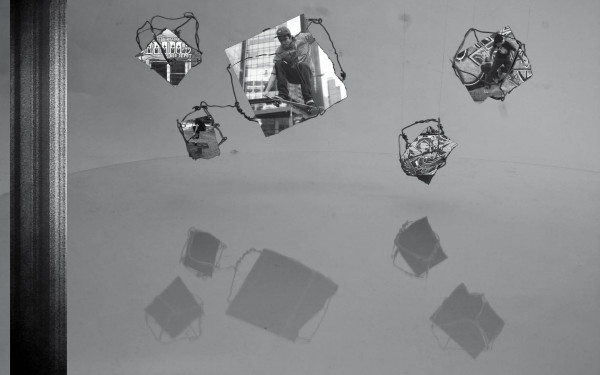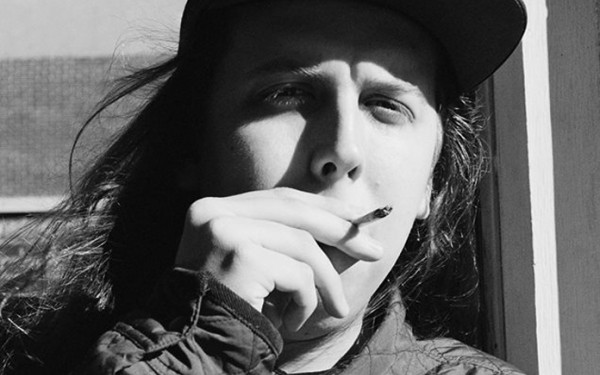Skate, Drink, Slam, Repeat
Montreal’s Premiere Skateboarding Bar Unveils Brand-New Bowl
Nestled in a nook along St. Laurent Blvd.’s main strip, with a bulky metal door adorned with a wreath of shattered Maplewood skateboard decks, the thrash-hold to TRH-Bar is pretty discrete from the outside.
But once you’ve taken a few steps up the steep, dark staircase with graffiti-plastered walls and hear the whoosh and rumble of skaters shredding the bowl, and the odd hooting and hollering rising to a crescendo of cheers and deck-tapping applause after someone sticks a banger trick, you know you’ve found the right place.
Sweat is palpable in the air upon entering, and beyond the Pabst Blue Ribbon-stacked bar and DJ booth is the core of the action—skaters whirling around the bowl surrounded by a rowdy crowd of onlookers, separated by a newly-installed wire fence and a loose mesh net reminiscent of a baseball game, there to catch unruly runaway boards rather than foul balls.
The bitter cold of winter has no power in this urban jungle—here, skateboarding is king.
Montreal’s premiere skateboarding bar, TRH-Bar (pronounced “Trash-Bar”) has only been open since April of last year, but has already become a hub of the Montreal skateboarding community. The main attraction is the newly remodeled wooden bowl on the first floor, situated in the centre of the complex, but a second level reveals a four-foot polyboard mini-halfpipe, a secondary bar, and a stage for bands and DJs.
The average first reaction to a skatepark/bar hybrid is one of shock and disbelief—how can insurance cover such a volatile mix of extreme sports, cheap alcohol and wild skateboarders?
Bar founders Fred Vitu and Joe Valina said it wasn’t easy—it took months to arrange the correct permits and secure insurance, coming from an unspecified foreign country. Finding the right location proved challenging as well.
“We were working for a year looking around. We were driving together all over Montreal to find the right place, making phone calls,” Vitu said.
The only known precedent to their skate project is alternative bar and venue Foufounes Electriques that once featured a mini-ramp, but the bar was forced to remove it due to lack of proper insurance.
“Before we tried to find the location, we had to find the insurance because of the Foufounes trouble. […] It took a long time to find it, but as soon as we had it, then we went forward,” Vitu said.
Even with the proper paperwork lined up, the skate bar still receives funny looks from some—most notably Montreal police.
“The cops, they don’t like us too much. Since the beginning, they’ve been coming a lot,” Vitu said.
As for the bar’s abbreviated name, Vitu said that was less an aesthetic choice than one forced upon him and Valina by the Quebec language police.
“Because of the Office de la langue française, we couldn’t call it ‘Trash Bar,’ so, in French, ‘T-R-H,’ when you say it, it [sounds like] ‘Trash,’” he explained.
New Bowl, New Blood
TRH-Bar’s original bowl was constructed free of charge by a friend of Vitu and Valina’s last year, and was quickly covered in a sleeve of colourful spray paint artwork and skated on for months.
But the integrity of the ramp was eventually compromised. Air pockets in the wood sent cracks spiraling through stressed areas, and the extension of the bowl (the higher-raised end that reaches a vertical degree) became haggard and difficult to skate on.
With the bar’s popularity taking off and sponsorships from companies such as Jagermeister and Pabst Brewing Company bringing in funds, Vitu was recently able to demolish the old bowl and build a new one from scratch.
“The skaters say, ‘Oh, that’s a shitty bowl,’ so let’s re-do the bowl. We’re here for them,” Vitu said.
Former professional skateboarder, events coordinator and Montreal native Eric Mercier signed on for the job of designing and constructing the new bowl. With 29 years of skateboarding under his belt and having built skateparks such as Montreal’s 83,000 square-foot indoor park Le Taz, TRH-Bar’s new bowl was an ideal endeavour.
“[The new bowl] is a better design, definitely. The materials are all the same, but if they’re not installed properly, they become shit,” Mercier said.
TRH-Bar held a launch for the new skate structure on Feb. 1, just three weeks after the initial demolition of the old bowl. The new bowl is larger, infinitely smoother and better designed than its predecessor. Just one revolution pumping around the corners can reap a massive boost of speed, and skaters can grind for much longer around the coping, producing more satisfying tricks—but also cringe-worthy high-speed slams.
At the launch, skaters were hungry to get tricks or die trying. There were multiple collisions as eager skaters dropped in at the same time, and daring photographers lurked at the edge of the bowl or even jumped in to snap a photo of elusive aerial tricks in the deep extension.
Skaters brought their A-game for the best trick contest, with wall plants, big airs and steezy stalls going down all night—a sign of all the shredding still to come.
“The cops, they don’t like us too much. Since the beginning, they’ve been coming a lot.”
—Fred Vitu, TRH-Bar co-founder
The Misfits and the Rebels
Vitu moved here from Soissons, France 10 years ago and hasn’t looked back since. For him, Montreal was the perfect place to realize his dream of owning a skate bar.
“It’s a great city—I’ve been travelling a bit around the world, and I love what’s happening here. I think it’s the best place to do this project,” he said.
Mercier agrees that TRH-Bar is highly unique, which perhaps explains why it’s already become a staple in the city’s skate scene.
“The concept is good—everyone goes out anyways, and in the wintertime at least you have the ramp to skate, so why not combine the two together?” he said. “The guys saw an opportunity to open a skate bar, with a bowl and a ramp. It’s a perfect combo for success, for the skate side of the bar scene.”
The bar has been host to a wide range of events. Professional skateboarders from around the world have visited, such as rising star Torey Pudwill and the legendary Chico Brenes. Skate videos have held their Montreal premieres at TRH, including Emerica’s latest video Made, along with music shows and more.
“We are always open for anybody to make an event here, whether a party, or film premiere or fashion show. Anything you want, you can do it here,” Vitu said.
“We’ve also had a harp player in the bar. […] She was playing harp, and there was graffiti [painting] at the same time and breakdancing.”
Vitu says TRH-Bar is a no-judgment zone as well—all are welcome to drink, shred, party and have a good time.
“[We] don’t judge about tattoos, or hairstyle, or dressing style or stuff like that. You can come wearing a shirt and a tie or a dress or be all dirty; we don’t care,” he said. “As long as you respect the people next to you, it’s perfect, you’re welcome in the bar.”
Vitu says first-timers at TRH are often taken aback by the total immersion in skate culture, with walls layered in graffiti, skate decks hung up and even built into the very integrity of the bar’s surface, skate videos constantly playing on screens everywhere, and of course the ramps themselves—it’s a skatopia dream finally realized.
“Everytime you see a new person coming in the bar, you just have to see his face, just see the surprise,” said Vitu. “I don’t know what you can expect. Don’t expect to have a really clean couch, or the best champagne to drink, or a fancy cocktail.
“Don’t come for that. Come for everything else.”

_900_597_90.jpg)
_900_597_90.jpg)
_900_597_90.jpg)
_900_597_90.jpg)
_900_597_90.jpg)
_900_597_90.jpg)
_900_597_90.jpg)
_600_832_s.png)


_600_375_90_s_c1.jpg)
